
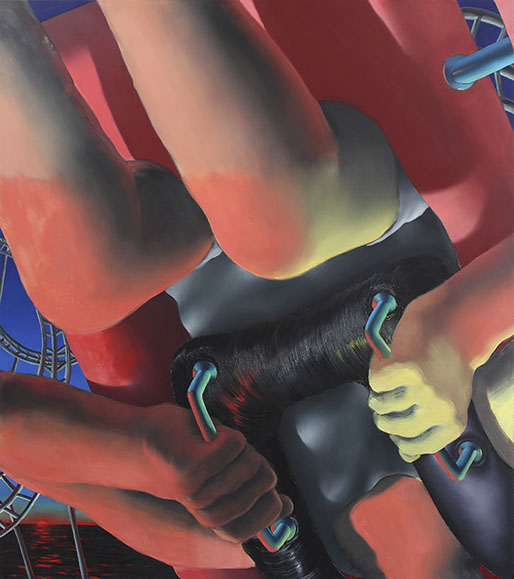
Roller Coaster, 2016
oil on canvas, 78 x 68
photo: courtesy Jordan Kasey
Alyse Ronayne with Jordan Kasey
Alyse Ronayne: Hi Jordan.
Jordan Kasey: Hi Alyse.
AR: How are you?
JK: Great!
AR: I’m really excited to talk to you about your show at signal because I loved it. I thought it looked really good. The title of your current show at signal is Free Time. We’ve talked about how when you were trying to come up with a title of the exhibition before your show. Microclimate was another option. You and I had a show together in March at Greenpoint Terminal Gallery and the title of that was At your Leisure. I’m interested to hear how you decided on this title.
JK: I was thinking originally of the air or the space within the paintings, or the space that they create by interacting with each other–both the environment they create for the viewer and referring to my use of light. In the end, I decided the title should be more about the experience of the figures in the painting that connects them in some way. I really liked the title At your Leisure. I remember thinking that I wish I could use that one again.
Someone made a comment to me once: “Oh Jordan your paintings, they’re cool, what, they’re all of people relaxing”. I had never even thought of that. That was a good observation. It’s always fun to hear what other people see in your paintings. It’s always the things that are so present that you don’t even see because you're seeing them all the time. I thought at your leisure was a good title and I was trying to think of other things that were connected to that. I thought Free Time was an even more stripped down way of refereeing to something that is time to yourself or time that’s reflective/inner. Or sometimes even too much time on your hands...
AR: Yeah, it’s really in your head.
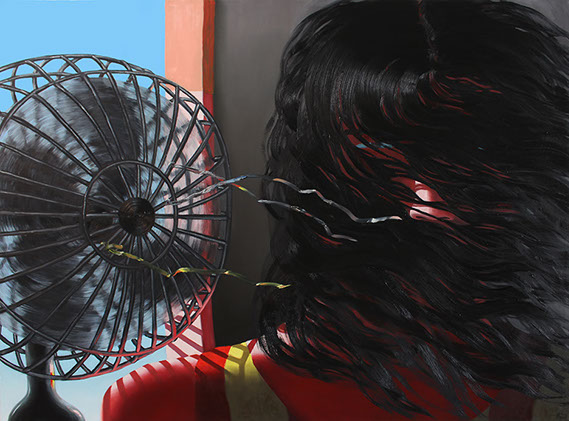
The Fan, 2016
oil on canvas, 57 x 72
photo: courtesy Jordan Kasey
JK: To me, the paintings are all these people who… None of them are at work. They’re all in situations they’ve put themselves in. Maybe they don’t seem to know why. That’s a feeling I can relate to. I feel like we all can sometimes.
There was a lot of time while I was working on the show where I felt like I had too much time in my head. It probably reflects in the work. The work and the imagery, it’s all very personal and intuitive. They end up coming from my own experience.
AR: Did you go on a lot of vacations when you were younger?
JK: No I didn’t. Every summer we would visit family in the south. We lived in Chicago and we would take a road trip every summer to the same cousins and grandmas. I have travelled a lot as an adult. My childhood was kind of boring. I barely even played outside. There weren’t neighborhood kids and there wasn’t nature accessible from where I lived. There were many hours of boredom and watching TV–excruciating boredom. But I drew a lot, and I had an imaginary land when I was little with my brother. That occupied a lot of my time as a child.
I was in Baltimore for five years after graduating from MICA. I stayed there partly because I could afford to leave for a few months out of every year and visit different places. I could also afford to be painting a lot and not be working that much. I was taking a lot in during that time and also producing a lot even though I wasn’t in New York and producing in any kind of actual art scene.
AR: So were the paintings in Free time were all made in 2016?
Mountain Top, 2015
oil on canvas , 65 x 95
photo: courtesy Jordan Kasey
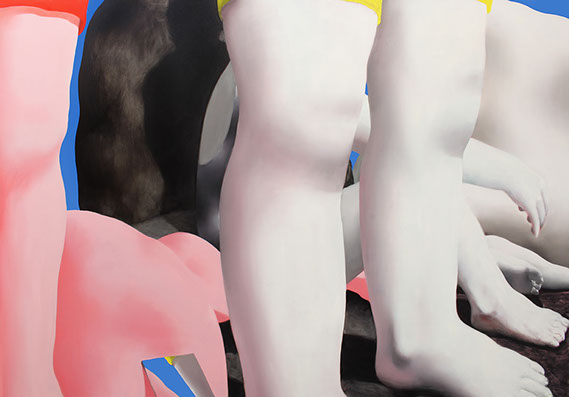
JK: Yeah, within the last 6 months or so.
AR: These paintings, to me, less so than your previous paintings… There’s one painting I’m thinking about, Mountain Top, where people were hiking up a mountian. There was a very physical quality to it. I think the works in the current show feel like hung over paintings–especially Tired at Breakfast and The Fan.
JK: The people in some of these paintings don’t have much energy.
AR: Why is that?
JK: I guess the figures don't seem to have much energy because I like the idea that they are exhausted by something, or kept awake by something, and we see them at a time when they are dealing with that, in some sort of introspective moment. Maybe they are paralyzed with tiredness or maybe just enjoying a relaxing moment. Maybe I was tired while I was drawing them. Plus work I make in the winter is usually darker, or more likely to be indoors. I started most of these when it was hibernation season. Also it helps to keep any narrative element minimal, to have the figures at rest rather than engaged in an activity.
AK: Does that relate to the anonymity of the figure? Is the figure universal? Even when we can see all their features, they still feel like anonymous figures. They’re not specific people.
JR: To me it’s important that the figures feel somewhat anonymous. They aren’t portraits of people I know. They’re not supposed to be renderings of specific people. I want the figures to be relatable to anyone. It’s more about the feelings they’re having or the sentiment they’re feeling or where they’re at psychologically than it is about their identity.
AK: The idea of space in your paintings is interesting–both physical space and psychological space. The roller coaster painting a good example of your depiction of physical space. The knee and the grasping hand are so in your face and in the lower left hand corner there’s a very far away, beautiful sunset. When we’re confronted with a face, we’re getting limited information. Psychologically, when I look at the anonymous faces, I’m seeing what’s going on in their head more so than their identity.
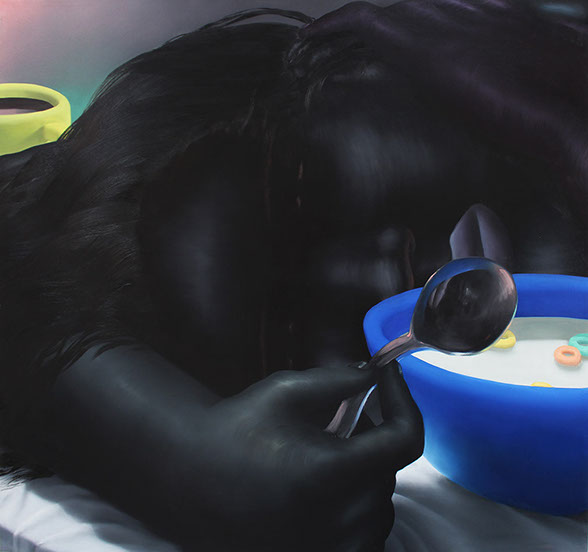
Tired at Breakfast, 2016
oil on canvas , 60 x 55
photo: courtesy Jordan Kasey
JK: Thinking about space and the role it plays in the pictures… where I see narrative is in telling a story through light and space, color and temperature, and setting. I like the picture to be something where you can’t imagine what happened right before or right after. It’s not like a still from a movie. It’s an object–an end in itself.
AR: The light in your painting is crazy. It feels very primary for you. Do your paintings come from drawings or do you start the picture right on the canvas?
JK: They start from doodles in my sketchbook. I don't do a lot of drawing or rendering. I don’t work out any of the light or color beforehand. I get an idea I’m excited about and I know what I want it to feel like before I know what I want it to look like. The drawings are really crappy. Sometimes I look back at them and sometimes it’s like a little kid did a drawing of my painting. But sometimes I look back and they don’t resemble the finished painting at all because the entire composition can change while I’m working on something. The process of making the painting is one of lots of interaction between me and the painting itself–listening to where it seems to want to go. If I try something and it looks really bad, maybe I can’t work on it for two weeks. Then two weeks later I might get some idea of how I can either completely change it or subtlety change it. But it’s different for every painting. Some of them work themselves out pretty quickly and with some of them it’s a crazy love/hate relationship that develops over months.
AR: When you say you’re working from a feeling, does that mean you want a painting to specifically feel a certain way?
JK: The weird thing is sometimes I don’t know exactly how I want them to feel. Or sometimes I don’t know how to put into words what it is that I’m excited about when I have some idea in my head that doesn't have much of a form. I like when the finished painting represents something that I can’t quite put my finger on or explain to people. I like when there’s a sense of mystery that isn’t forced and contrived. I like when it feels real to me for some reason and I don’t even know if I get it. A lot of times, years later, I look back at paintings I’ve finished and I’m like “of course I did that then, wow, I was making myself so vulnerable and I didn’t even know”.
AR: Can you talk a little bit about Person with Mirrors, where one figure is represented three times?
JK: It’s a person looking at their refection in some sort of vanity mirror. It’s a reflection and then a reflection of the reflection. Their eyes are kind of blank and they’re touching the fingers of one of the reflected images. The other shows the fingers just reaching out of picture. It’s about a person’s interaction with themselves. It’s about three different versions of the same person. The viewer is able to see three different versions of the same person in the same moment. And it’s about how the light is hitting the person–how that affects how we see them and who we might see them as.
AR: For me, this painting is one of the more dynamic paintings in the show. It takes me into the most psychological space. This sweater is super textured. There’s so much going on in it! It looks like it could be in a dressing room. So much happens psychologically in the space in a dressing room when you’re looking at yourself–in between when you’re deciding whether or not you’re going to buy something.
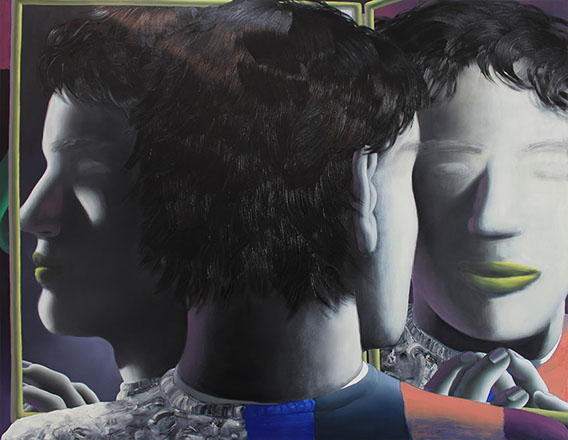
Person with Mirrors, 2016
oil on canvas , 78 x 102
photo: courtesy Jordan Kasey
JK: Yeah, like “I look really weird today” or “this isn’t how I look in the mirror in my house…”
AR: And sometimes you just look at your face and think about bigger things. This painting calls to mind all those physical and psychological issues.
JK: This painting went through a few stages. First, the person had sunglasses on, but they had to go because it was too much like “cool guy looks in the mirror”. Then he had a hat on and there was another hat that was hanging off the top left corner of the mirror. You can still see the remains of the bill of the hat in the left sliver. It was a green bill of a baseball cap. But then I was like “oh, this is now a painting about a person trying on different hats”. The hats had to go. I guess I enjoy stripping things down. In the end I had to decide to allow it to be this painting. I think this one is interesting because it’s the only one that has three figures. Even if it’s the same figure, the others are all solitary people who are engaged in their environment. Really this painting is of three people interacting with each other. In the end, I’m happy with how it turned out after the hats. With all the paintings, I like taking out any kind of unnecessary details. I like for anything that’s in the painting to be pointing to one main event, whatever that is. Even though sometimes I’ll be like “Oh but I really liked the houseplant in the corner” for example. Part of the painting process is a lot of editing out of things, deleting things, sacrificing things that maybe I really liked how I painted them. Or maybe they were the original thing I like about the painting, but suddenly the painting is about something else and it has to go.
AR: Do you ever use that to start the next painting?
JK: No examples of that come immediately to mind, but I’m sure that happens where I think “This will be better for another idea” and it gets tucked into a shelf in my brain. There’s definitely always a lot of interaction between the paintings. Like “ I like this purple in this paitning, I’ll put it in this one too”. Or “These people are both reclining but one’s indoor and one’s outdoor, one’s male one’s female, one’s day one’s night". I’m always seeing how they connect while I work on them. For the paintings in Free Time, I didn’t go out intending to make a series, but in the end they all kind of connect because I’m working on them all at the same time. I’m going through the same things while I’m working on them.
AR: Person with Mirrors, stands out to me in the same way that the reclining beach figure does, Shapes Person. That painting happens to be on the reverse side of the wall in the show. It’s in the other room and it feels like a bonus painting. It’s part part of the group, but the figure is the most abstracted. It feels like different components or limbs have all been fit together to make up the figure. The figure is reclining on kind of a bed of clouds or I like to think of it as a blow up beach toy. There’s a backdrop and brightly colored shapes that look like photo shoot props. There are bright red flip flops. We’re at the beach.
JK: In the background on each side, there are tiny slivers of beach landscape.
AR: Which opens up the space, but it makes me feel like a participant. It’s like this person is asking for… not necessarily a voyeur, but a spectator. Whereas when I look at the person on a roller coaster, I don’t feel like I’m a spectator.
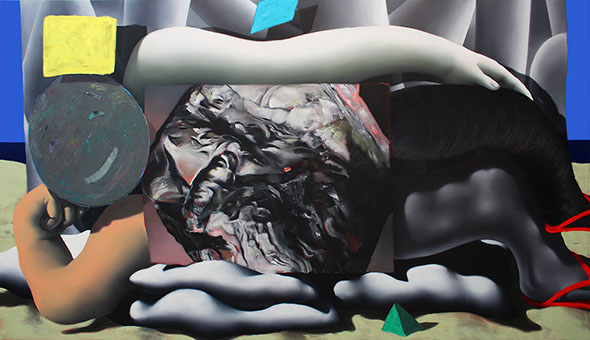
Shapes Person at the Beach, 2016
oil on canvas , 68.5 x 108
photo: courtesy Jordan Kasey
JK: Right. They’re in a private place. When they’re on a roller coaster and they’re engaged with their own terror and discomfort. This person on the beach is definitely posing the way a person might for a photo shoot. And there’s a backdrop as though it’s the shapes-world backdrop set up for the shapes-person. This one is really different. When we were setting up the show there was a debate about which one goes on which side of the wall, this one or the one with three faces. We kept going back and forth. I like how you put it, saying it’s like a bonus painting, because you’re unsure if the show continues beyond the back wall. And the painting is totally different. It rounds the show out. This person is looking at me from their bizarre world that is a lot less familiar. It’s more like encountering a Cheshire cat. This person is kind of inaccessible. They look friendly, but maybe nervous and maybe giddy and showing off.
AR: The paintings in the main space feel like where I see you moving and this beach painting feels like it’s more related to paintings you’ve made in the past. Your past repertoire is on full display in this painting. There’s a rubbery black that makes up one of the legs. This kind of face is very familiar in your work. And the torso kind of looks like it could be a bathing suit, but it also looks like a rectangular painting that you’ve put in front of the figure. It’s very textured, like the way I’ve seen you make rocks and elements of the landscape.
JK: The thing that’s the torso is actually directly rendered from a photograph of a rock at the Natural History Museum from about a year and a half ago. I did about 80 little studies that took an hour each based on photos I took of different rocks. I was exploring different ways that texture and light hit different surfaces. I’ve always been really interested in rocks. I’m interested in the figures having rock-like flesh to make them seem of the Earth, or permanent, or monumental, or even just strong and having lots of weight. That ties in with the scale too. But this paintings is kind of like a joke. This person’s torso is rock. It’s a painting of a rock. It’s one of the last things I painted in. For a long time it everything was painted except for the torso. It was just a red rectangle that was left red because the underpainting was red. I thought it was like a picture frame and I decided which picture to put in the picture frame. That’s part of why my mind went to just blowing up a painting I’d already made. I got the same old photo out and just rendered it larger this time. I like how it kind of looks like an abstract painting. It looks more brushy. It’s a painting within a painting. And maybe it’s what this person’s organ’s look like. One person told me it looked like an expressive painting of damned souls.
AR: All these figures are larger than life. All the canvases are larger than your body for the most part.
JK: Yeah, they’re roughly my size or a little bigger. I enjoy the physical act of working on something that is about my size, that I have to walk around and sometimes go up on a ladder or stool. I really don’t like sitting down while I’m working. I enjoy working on something that’s filling my field of vision while I’m doing it, so I can get immersed in that world. While mentally occupying myself with it, it occupies my visual field. I feel like the experience of having these larger than life figures looming over me while I’m trying to work on them is kind of intense. I guess I enjoy the power dynamic between me and the piece when it’s sometimes this huge hideous thing that I hate. All I have to do is to work on it or try to fix it. It can be pretty humbling, but the reward is there in the end.
Also for the viewer, it’s important with figurative work, there’s always the decision whether the figure is going to be larger than life, smaller than life, or life sized. For my work, the concept, it’s important for me that they’re larger than life because there’s something monumental or intimidating or confrontational that I like the figures in the painting to have, to force the viewer to deal with that, to interact with them or feel what it feels like to be confronted by them.
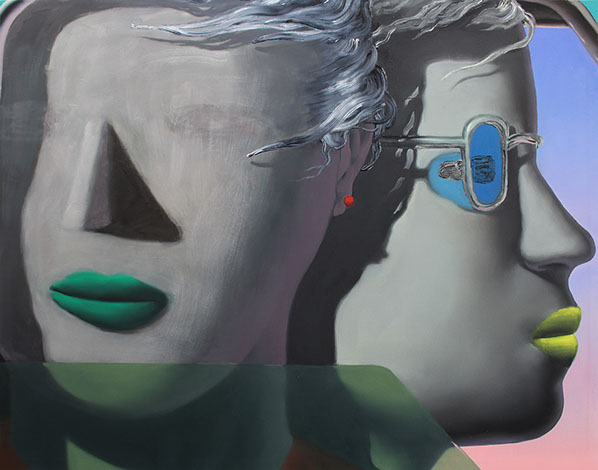
Passenger and Driver, 2015
oil on canvas , 42 x 54
photo: courtesy Jordan Kasey
AR: Who are some painter’s you’ve been really into lately or shows you’ve seen that you’ve really liked?
JK: I liked the Shara Hughes show at Marlborough a lot. I also liked the Fischli and Weiss show at the Guggenheim. I really loved that show. I recently saw the Sigmar Polke show at David Zwirner, also really loved that. The Nicole Eisenmann show at the New Museum, and her show at Anton Kern were really good. I like her work a lot, though there are some things about it that irritate me a little. Sometimes with her hand, you can tell the draftsmanship skills just come so easily, it almost has an illustration-like quality. Also, sometimes the art-historical references that are so blatant and obvious... I find that a little unnecessary. To me it’s more interesting when there’s just the struggle the artist is having with their own hand than them cleverly and easily slipping in these images for you.
AR: I always think of the art-historical references being related to queerness. Do you know Deb Kass? One of the first paintings of her’s I saw -she’s obsessed with musicals and queerness- she made a painting that was a quote from a musical but is said Daddy I’d love to dance. It was a text painting. In the background is Warhol’s Camo and the letters are full of Pollock drips. It’s very blatantly attacking art history as a boys club and saying “I can do this as well”. Maybe it’s not a queer thing, but a feminist attack to reference art history this way–“I can do it too.”
JK: Well, I’ve had a lot of people say to me “Oh you’re Jordan. I thought the artist was a man!”. I’ve had people do Instagram and say “look at his paintings.” Part of me wonders is that a compliment or is that really shitty? I guess especially in the previous generation, Jordan was a lot more common as a male name. But I do think that’s something interesting about it. There are all these subtle things.
Maybe that is part of why I want to make them so big. I like building my own stretchers and I’m like yeah, I can do this! I like doing this! But I don’t know, if I was a man, I probably would also like building them. I’m interested in the ways that -maybe not so blatantly or intentionally- gender comes up in my work. But I wouldn’t say my work is about identity. Part of me likes the way that people don’t really know who made these paintings. I want them to be pointing towards something bigger than my own identity or an inside joke with the art world.
AR: The person in The Fan, I’ve assumed was a woman. And there was a painting you had at Greenpoint Terminal, Passenger and Driver, where somebody has a red earring in their ear. I always thought that was a woman as well. But there’s rarely anything overtly stating what gender any figure is. I feel like that adds to the universal, relatable quality.
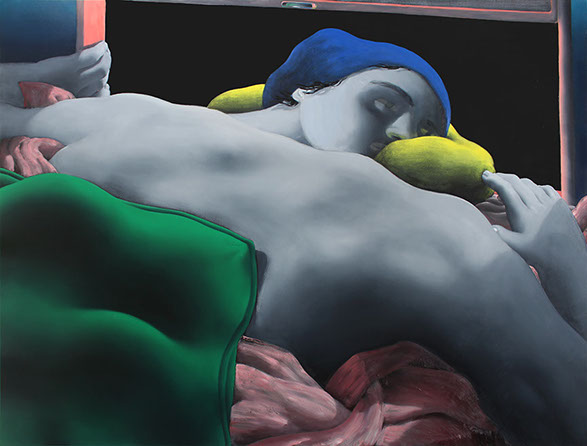
"I can't Sleep!”, 2016
oil on canvas , 76 x 102
photo: courtesy Jordan Kasey
JK: Gender used to be something I would completely try to avoid. People used to say I painted blob people. Then I became interested in adding more details to the figures, I didn’t want them to look like aliens. I had to give them some sort of hairdo. But I did start to get interested in why I decided to make one a female painting and one a male painting. I’m not sexualizing them being like “This is a woman and you can tell because she’s wearing a really sexy outfit and her boobs are there”, you know? And they’re huge! In mine, it’s more like this is a person who happens to be female. I’m not trying to make any statement about that.
AR: What’s on the horizon for you? Where can we see your paintings next?
JK: This show at Signal will be up through June 26th. Hopefully people have a chance to see that. I also have some work up right now at Thierry Goldberg in a group show. I have a couple other group shows coming up this summer. In July, I’ll have work in the Johannes Vogt Summer Barn show in East Hampton and at New Release in Chinatown, I’ll be in their group show in September. I’ll also be in a two person show at Alyse’s gallery at her house in September with Tessa Perutz–In Limbo. Further along the horizon, I’m very excited about another solo show in February that will be at Nicelle Beauchene.
AR: Last question, what’s your favorite smoothie to make?
JK: I love making smoothies, especially in the summer! The thing I make most often has bananas, strawberries, and beets that make it really pink. Maybe some mango. I always put sorrel juice in it. I always make sorrel juice at home. And then some yogurt.
AR: That sounds delicious. Ok, thanks Jordan!
JK: Thank you Alyse! This has been so fun.
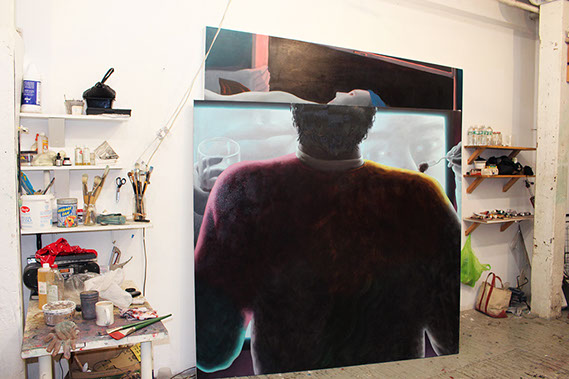
Studio of Jordan Kasey, 2016
photo: courtesy Jordan Kasey
Jordan Kasay: Free Time
May 27th - June 26th, 2016
Signal Gallery
260 Johnson Avenue
Brooklyn, NY 11206
347-746-8457
Hours
Saturday and Sunday
1:00 PM - 6:00 PM
Jordan Kasey is an artist in Brooklyn, NY. She earned a BFA from MICA in 2008. Recent Exhibitions include At Your Leisure, a two-person show with Alyse Ronayne at Greenpoint Terminal; Headspace, with Carolyn Salas at Phoebe; Real Things about Real Things at American Medium; and Artemisia at Cuevas Tilleard, New York, New York.
Alyse Ronayne is an artist and curator in Brooklyn, NY. She earned an MFA from Bard College in 2015. Recent exhibitions include Marbo at Culture Room, Brooklyn NY; Live Inside Your Head at Jeff Bailey Gallery, Hudson NY; At Your Leisure with Jordan Kasey, Greenpoint Terminal Gallery, Brooklyn NY; and FOUND at Leslie Lohman Museum, New York NY.
Disclaimer: All views and opinions expressed are those of the authors and do not necessarily reflect the views of the editors, owner, advertisers, other writers or anyone else associated with PAINTING IS DEAD.
